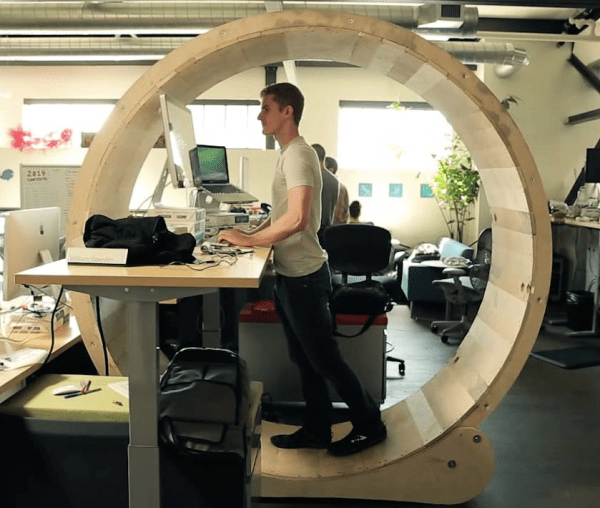Should You Take a Stand at Work? Kinesiology Experts Debate the Benefits of Standing Desks

Ernest Hemingway, Charles Dickens, Winston Churchill, Virginia Woolf, Vladimir Nabokov, Thomas Jefferson and Benjamin Franklin—what do these highly successful figures have in common?
They all used standing desks.
In fact, you may be reading this while standing at your desk.
Standing desks and active workstations have become a trend in offices to combat sedentary workplace routines. Sedentary behavior, or periods of sitting or reclining for 30 continuous minutes, is widely accepted as an independent risk factor for weight gain, obesity, metabolic disease, diabetes, some cancers and premature mortality.
But among the flux of articles advocating for the standing desk by warning against too much sitting, does the standing desk pose risks, and is it as beneficial it is made out to be?
Kinesiology lecturer Juliana Marino, and Adam Lavis, a clinical exercise physiologist who runs UNC Charlotte’s kinesiology labs, collaborated to provide expert insight into the standing desk conversation.
Can you discuss the current studies about standing desks, and whether they are significant enough to provide any health benefits?
The literature supports an increase in energy expenditure associated with the use of sit-stand desks, but perhaps not to the extent at which the claims suggest. The increase in caloric expenditure associated with standing is modest, and it not likely to contribute to weight loss, thought it may help prevent weight gain.
The current recommendation is that people with sedentary jobs to strive to accumulate 2-4 hours per day of standing to light activity during work hours. To achieve that, people should break up extended period of seated work with standing and walking. This can be done through use of sit-stand desks or “active” breaks.
Does standing, even for brief periods every hour, trigger an increase in metabolism?
The total increase in caloric expenditure going from sitting to standing is modest at best. For example, if a 150lb man expended 60 calories during 60 minutes of seated work, he might expend just an additional 6-8 calories during that hour if he were standing. Standing requires that we engage our postural muscles, but is not likely to improve muscular fitness.
What is the correct way to use a standing desk?
The correct way to use a standing desk is to incorporate bouts of standing for at least five minutes every half hour. An incorrect way to use this desk is to stand statically (without movement) for prolonged periods of time. It is best to shift weight from foot to foot so as to initiate some muscle contraction and prevent blood pooling in your lower extremities.
What is the acclimation process like for people transitioning to a standing desk?
People should not experience musculoskeletal pain when working at a sit-stand desk. If someone does not have a previous orthopedic injury, but experiences pain, an evaluation of posture and movement may be warranted. Fatigue would be a normal part of the adaptation process and should be alleviated with periods of rest or posture change.
Is there a need for further equipment, like adjustable chairs or padded mats?
No further equipment is necessary.
Individuals need to consider footwear that is comfortable, supportive and helps to maintain their balance. For example, prolonged standing in high heel shoes may cause musculoskeletal pain. One may need to consider proper height of monitor and keyboard. Perhaps consulting an ergonomist is wise; standing for extended time with bad posture is problematic so a consultation with an ergonomist to assess proper height of the standing desk may be effective.
Do you think a standing desk is a better alternative than other interventions?
No. We encourage movement of any kind throughout the day; for example, walking meetings, taking a walking break, standing during phone calls, exercising during lunch hour, taking the stairs, and parking farther away.
If the budget allows, the use of wearable technology like a Fitbit may be an incentive to move more.
The absence of a sit-stand desk should not be seen as a barrier to physical activity. The desks can be cost-prohibitive; some models are priced upward of $400. Other options, like walking to the drinking fountain, are free!
Can a standing desk make you “healthier”?
We know that behavior change is very complex. It is unclear whether the use of a standing desk could impact lifestyle modification or health behaviors. What is known is the standing desk is a symbol for a more active lifestyle. The sit-stand desk offers a solution in a setting where we accumulate many of our sedentary waking hours. We don’t yet know if the desk would cause someone to be more active outside of work. Some suggest that use of a sit-stand desk may cause compensatory behaviors outside of the workplace, including more sedentary time at home.
—
Although a stand-capable desk has benefits for its users, long-term intervention studies are needed to better understand the cardiometabolic effects on the extended use of standing desk. And whether a standing desk will enable you to become as successful as Hemingway or Churchill? The relationship to productivity is another discussion entirely, but it’s clear that for many, standing desks have stood the test of time and preference in the workspace.
by: Tayler Greene